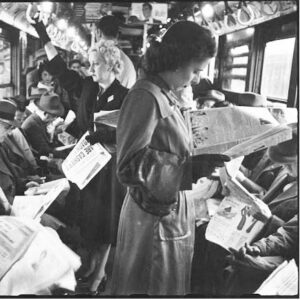
And Trump has a major lead among those who don’t follow political news — 53% back him, and 27% back Biden.
Furthermore, the Pew Research Center explained:
Among adults, those ages 18 to 29 are most likely to say they regularly get news on TikTok. About a third of Americans in this age group (32%) say they regularly get news there, a higher share than in years before. More of TikTok’s U.S. adult users are getting news there as well.
NEWS CONSUMPTION IN THE PAST
Newspapers have been a major contributor to political news beginning as early as 1690. The 19th century, however, was the golden age for partisan press. Competition was stiff, and publishers often went for scandal and sensationalism to sell newspapers.
The early 20th century saw the rise of investigative journalists (aka muckrakers) who challenged those in power. Lincoln Steffens, Ida Tarbell, Upton Sinclair, David Graham Phillips, and Ida B. Wells led the charge, bringing in the journalistic culture of objectivity. Because of this movement, we now see newspapers clearly differentiating from news stories, editorials, columns, and letters to the editor.
This culture, however, has led to some interesting outcomes. Some journalists will present an opposing viewpoint as being more equal than the evidence allows to appear fair. The science for climate change and vaccines, for example, is overwhelmingly one-sided, but many times the skeptics get equal footing.
The emergence of radio in the 1920s again altered the landscape. Politicians could speak directly to the people without being challenged. Franklin Roosevelt’s “fireside chats” were extremely effective.
NEWS CONSUMPTION AND THE FAIRNESS DOCTRINE
In 1949 television entered the landscape. Lawmakers became concerned that the monopoly audience control of the three main networks, NBC, ABC, and CBS could misuse their broadcast licenses to set a biased public agenda. To guard against this possibility, they passed the Fairness Doctrine. This policy mandated that broadcast networks (radio and television) devote time to contrasting views on issues of public importance to maintain their broadcast licenses. Additionally, they were to design programs so that the public had a reasonable opportunity to hear different opposing positions on issues they covered.
Scrapping the fairness doctrine in 1987 has helped give rise to the resurgence of partisan media in the United States. This, in turn, has contributed to the polarization of American politics. As Lawrence Lessig has written, “The general effect of news network polarization is clear: polarized networks make for a more polarized nation—in at least the minimal sense of being more consistently sorted along ideological lines than before.”
FINAL THOUGHTS ABOUT NEWS CONSUMPTION
My first thought was that we should bring back the fairness doctrine. However, with the advent of social media, fairness would be impossible to implement and control. Therefore, it is up to individuals to adopt the mantra “trust but verify” on anything they hear or see. And how is that done? By thinking critically and gathering information from a variety of sources.
According to the University of Louisville, Critical thinking is the intellectually disciplined process of actively and skillfully conceptualizing, applying, analyzing, synthesizing, and/or evaluating information gathered from, or generated by, observation, experience, reflection, reasoning, or communication, as a guide to belief and action.
While Texas schools teach this concept, it is difficult to imagine you can practice it if you get all your information from TikTok. Most of the clips are short, leaving little time for reflection and analysis.
As a nation, we must do better.
Sign up on www.mariewatts.com to receive future Stories About Life delivered to your email address or read more stories by clicking here.

Recent Comments